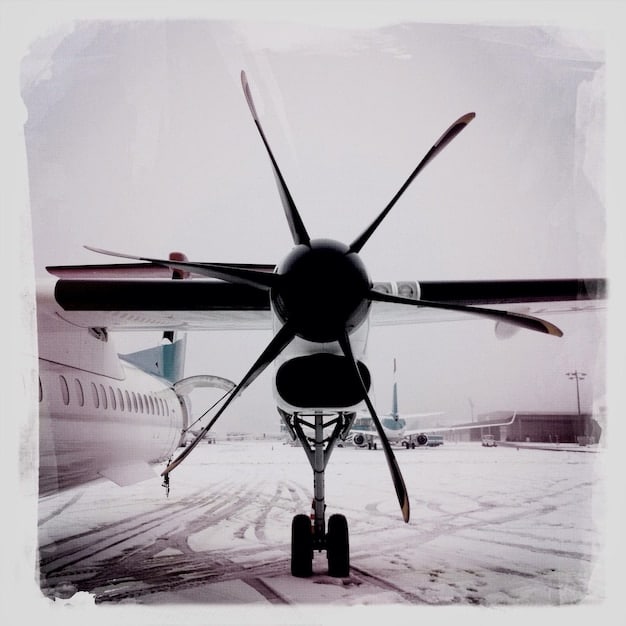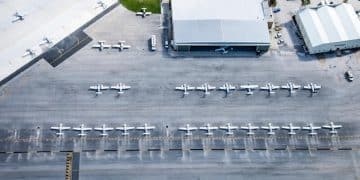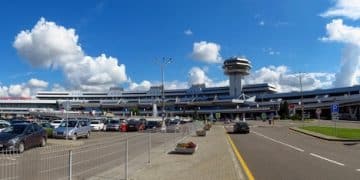Airline Mergers & Acquisitions: Understanding the Consolidation Trend

Airline mergers and acquisitions are consolidating the aviation industry landscape, driven by factors such as cost reduction, increased market share, and enhanced operational efficiency, ultimately impacting competition and consumer choices.
The aviation industry is no stranger to turbulence, but one trend remains consistently on the horizon: airline mergers and acquisitions: what’s driving the latest consolidation trend?. These high-stakes deals are reshaping the competitive landscape and leaving many wondering about the motivations behind them.
The Historical Context of Airline Consolidation
To understand the current wave of airline mergers and acquisitions, it’s crucial to look back at the history of consolidation in the aviation industry. Several major mergers have shaped the market we see today.
Early Mergers and Deregulation
The Airline Deregulation Act of 1978 played a pivotal role, removing government control over fares, routes, and market entry. This deregulation led to increased competition and, subsequently, financial pressures on many airlines.

As airlines struggled to compete in this new environment, mergers became an attractive option for survival and growth.
- 1986: Northwest Airlines and Republic Airlines merged, creating a larger network and more efficient operations.
- 2005: America West Airlines acquired US Airways, saving US Airways from the brink of financial collapse and creating a stronger competitor
- 2008: Delta Air Lines and Northwest Airlines merged.
These early mergers set the stage for further consolidation, proving that combining resources could lead to greater stability and market power. In the contemporary landscape, this history informs today’s strategies.
The initial wave of mergers and acquisitions in the late 20th and early 21st centuries dramatically reshaped the airline industry, setting a precedent for the further consolidation we are witnessing today.
Economic Pressures and Cost Synergies
One of the primary drivers behind airline mergers and acquisitions is the potential for significant cost savings. Airlines operate in a highly competitive, capital-intensive industry where even small cost reductions can have a major impact on profitability.
By merging, airlines can achieve economies of scale, streamlining operations, reducing redundancies, and negotiating better deals with suppliers.
Fuel Efficiency and Fleet Management
Fuel is one of the largest expenses for airlines. Merging allows companies to optimize their fleets, retiring older, less fuel-efficient aircraft and investing in newer models. This can lead to substantial savings over time.
Consolidated airlines also have more negotiating power with aircraft manufacturers, securing better prices and delivery schedules for new planes.
- Reduced maintenance costs through standardized fleets
- Improved fuel efficiency from newer aircraft replacing older models
- Greater bargaining power with fuel suppliers
By cutting per unit expenditure and reducing overhead, mergers can translate into healthier bottom lines and better prospects for long-term sustainability amid fluctuations in the market.
The pursuit of cost savings is a critical motivator for airline mergers and acquisitions, enabling companies to weather economic storms and invest in future growth.
Expanding Market Reach and Network Optimization
Beyond cost savings, airlines also seek to expand their market reach and optimize their networks through mergers and acquisitions. Combining routes and hubs can provide access to new markets and create more efficient connections for passengers.
A larger network can attract more passengers, especially business travelers who value convenient and frequent flights to a wide range of destinations.
Strategic Route Development
Mergers can enable airlines to fill gaps in their route networks, offering more comprehensive coverage and competing more effectively with larger rivals. By combining complementary routes, airlines can provide seamless travel experiences for passengers.

A well-planned merger can transform a regional airline into a global player, unlocking new revenue streams and increasing brand visibility. A key factor in the decision making process.
- Increased access to international markets
- More efficient use of airport slots
- Enhanced ability to compete with major global airlines
Network optimization is essential for staying competitive in the global aviation market, and mergers and acquisitions offer a powerful tool for achieving this goal.
Mergers allow airlines to significantly bolster their market presence by reaching new locations and optimizing flight options, creating networks that are greater than the sum of their parts.
Competitive Pressures and Industry Consolidation
The airline industry is characterized by intense competition, with numerous players vying for market share. This competition can drive down fares and profit margins, making it difficult for airlines to remain profitable on their own.
Mergers and acquisitions can reduce the number of competitors, creating a more stable and rational pricing environment. This can benefit airlines by allowing them to charge fares that reflect the true cost of providing service.
Reduced Overcapacity
When too many airlines operate on the same routes, it creates overcapacity, leading to empty seats and lower fares. Mergers can eliminate this overcapacity, helping airlines to fill more seats and increase revenue.
A more consolidated industry is also less susceptible to price wars, which can be devastating for airlines’ financial health. Therefore, those in charge have the incentive needed to green-light buyouts.
- Fewer airlines competing on the same routes
- More rational pricing strategies
- Greater stability in the market
While consolidation can be good for airlines, it’s essential to consider the potential impact on consumers, such as higher fares and reduced choice.
In the effort to become more competitive and secure, mergers reduce excess capacity, leading to a more stable pricing structure and improving all involved’s financial health.
Regulatory Environment and Government Oversight
Airline mergers and acquisitions are subject to regulatory review by government agencies, such as the Department of Justice (DOJ) in the United States. These agencies evaluate proposed mergers to ensure they do not harm competition or consumers.
The regulatory approval process can be lengthy and complex, requiring airlines to provide extensive data and analysis to demonstrate that the merger is in the public interest.
Antitrust Concerns
One of the primary concerns of regulators is whether a proposed merger would create a monopoly or significantly reduce competition in certain markets. Regulators also consider the potential impact on fares, service quality, and employment.
In some cases, regulators may require airlines to make concessions, such as divesting certain routes or assets, to gain approval for a merger. Government involvement is required to proceed fairly across the board.
- Scrutiny of market concentration
- Assessment of potential harm to consumers
- Requirements for divestitures or other remedies
The regulatory environment plays a crucial role in shaping the landscape of airline mergers and acquisitions, ensuring that these deals benefit both airlines and the public.
Governmental procedures and oversight are vital to airline mergers, as they protect the integrity of the aviation sector and guarantee both airlines and the public receive fair treatment.
The Future of Airline Consolidation
The trend of airline mergers and acquisitions is likely to continue in the coming years, driven by the factors discussed above. As airlines seek to improve their financial performance, expand their networks, and compete more effectively, mergers will remain an attractive option.
However, the future of airline consolidation is not without its challenges. Regulators will continue to scrutinize proposed mergers carefully, and airlines will need to convince them that their deals are in the public interest.
Emerging Technologies and Business Models
The rise of new technologies, such as artificial intelligence and blockchain, could also impact the future of airline consolidation. These technologies could enable airlines to operate more efficiently and collaborate more effectively, reducing the need for mergers.
Additionally, the emergence of new business models, such as low-cost long-haul airlines, could disrupt the industry and create new competitive dynamics. As the industry evolves, consolidation may continue in new light.
- Impact of AI and blockchain on airline operations
- Challenges to convince regulators and the public for deals
While the future of airline consolidation is uncertain, it’s clear that this trend will continue to shape the aviation industry for years to come. By keeping that into consideration, one can better strategize.
In conclusion, while issues do persist, the trend toward mergers and acquisitions across airlines will likely persist, influencing the future of aviation in transformative ways.
| Key Point | Brief Description |
|---|---|
| 📉 Cost Reduction | Mergers streamline operations and reduce redundant costs. |
| ✈️ Network Expansion | Combined routes offer passengers more travel options. |
| 🛡️ Competitive Edge | Mergers create stronger competitors in the market. |
| ⚖️ Regulatory Oversight | Government agencies ensure fair competition and consumer protection. |
FAQ
▼
Airline mergers are primarily driven by the desire to reduce costs, expand market reach, enhance operational efficiency, and increase competitive strength within the industry.
▼
Mergers can potentially lead to increased ticket prices due to reduced competition, but some argue that they provide stability, allowing airlines to invest in service and upgrades.
▼
Regulators, such as the Department of Justice, evaluate proposed mergers to ensure they do not harm competition or consumers by creating monopolies or reducing service quality.
▼
Recent notable mergers include the combination of Alaska Airlines and Virgin America, as well as the earlier merger between Delta Air Lines and Northwest Airlines, which significantly altered the industry landscape.
▼
Consumers might benefit through improved route networks, better integration of frequent flyer programs, and investments in new technology, though the immediate benefits can depend on the specifics of the merger.
Conclusion
In summary, airline mergers and acquisitions: what’s driving the latest consolidation trend? continue to reshape the aviation industry. Driven by economic pressures, the desire for expanded market reach, and the need to stay competitive, these consolidations have become a defining feature of the airline landscape. Despite the challenges and regulatory scrutiny involved, the trend is expected to persist as airlines seek greater stability and profitability in an ever-evolving global market.





